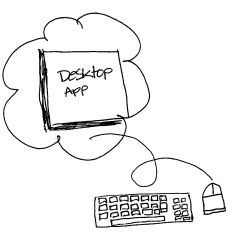Is it Cloud or is it Desktop?
There are a few realities that users of purely SaaS-based solutions are finding, and among them is that most web-based applications don’t readily integrate with the desktop – and the desktop is still where a lot of the real work gets done. Yes, users are increasingly mobile and are using smartphones and tablets to create and access information via mobile applications and services, yet the PC desktop – whether it’s an actual desktop computer, laptop or full-featured tablet – remains as the workhorse for business. Even the most popular SaaS applications continue to rely upon the desktop and locally installed applications to get some of the work done (note that many Salesforce.com users still find Excel to be their most effective reporting tool). In an effort to deliver mobility for those applications traditionally tied to the desktop, software developers have adopted two main approaches: redevelop the application for the web (which usually means bringing functionality down to a lowest-common-denominator approach), or applying a traditional terminal server or virtualized application approach and calling it “cloud”.
Neither option is awesome for the software maker – the time and cost of development certainly isn’t low, and the realities of hosting conventional desktop or LAN-based applications in shared infrastructure are pretty ugly at best. What these software makers need is a way to allow businesses to continue to use their software for the desktop and LAN, enabling the user with software license use rights to access that software product and associated data on any of their “desktops”, regardless of where that desktop might be (or what device it is running on). The model is cloud, but then it’s a desktop model too.
Independent software vendors are more frequently turning to platform providers (PaaS) to help deliver whatever “cloud” approach the company elects, and these ISVs are also feeling the bite of outsourced service fees and growing costs of delivery. It is not just the direct customer questioning the cost of deploying resources in the cloud – software providers are questioning these costs, too, especially as they attempt to deliver resource-intensive solutions from hosted infrastructure that bills them based on resource utilization. MyQuickCloud is proving that ISVs and their customers no longer have to bear large infrastructure costs in order to deliver complete user mobility. MyQuickCloud supports IaaS providers and their partner networks, allowing infrastructure-as-a-service offerings to include a simple and fast way to immediately make that infrastructure useful for desktop and application delivery.
The information technology industry has seen a lot of disruption in recent years, with complexity and risk in systems rising as users demand more functional mobile capability and software developers struggle to protect and preserve their assets (users included). MyQuickCloud jumps right into the middle of it, delivering solutions for business customers, software developers and cloud providers alike, and answering the question of whether it’s cloud or desktop. The answer is “yes”.
 Make Sense?
Make Sense?
J


